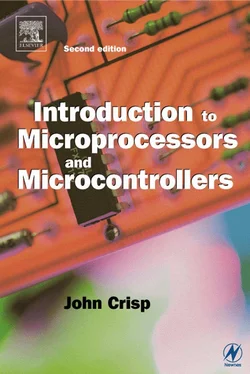John Crisp - Introduction to Microprocessors and Microcontrollers
Здесь есть возможность читать онлайн «John Crisp - Introduction to Microprocessors and Microcontrollers» весь текст электронной книги совершенно бесплатно (целиком полную версию без сокращений). В некоторых случаях можно слушать аудио, скачать через торрент в формате fb2 и присутствует краткое содержание. Год выпуска: 2004, ISBN: 2004, Издательство: Elsevier, Жанр: Компьютерное железо, на английском языке. Описание произведения, (предисловие) а так же отзывы посетителей доступны на портале библиотеки ЛибКат.
- Название:Introduction to Microprocessors and Microcontrollers
- Автор:
- Издательство:Elsevier
- Жанр:
- Год:2004
- ISBN:0-7506-5989-0
- Рейтинг книги:3 / 5. Голосов: 1
-
Избранное:Добавить в избранное
- Отзывы:
-
Ваша оценка:
- 60
- 1
- 2
- 3
- 4
- 5
Introduction to Microprocessors and Microcontrollers: краткое содержание, описание и аннотация
Предлагаем к чтению аннотацию, описание, краткое содержание или предисловие (зависит от того, что написал сам автор книги «Introduction to Microprocessors and Microcontrollers»). Если вы не нашли необходимую информацию о книге — напишите в комментариях, мы постараемся отыскать её.
Introduction to Microprocessors and Microcontrollers — читать онлайн бесплатно полную книгу (весь текст) целиком
Ниже представлен текст книги, разбитый по страницам. Система сохранения места последней прочитанной страницы, позволяет с удобством читать онлайн бесплатно книгу «Introduction to Microprocessors and Microcontrollers», без необходимости каждый раз заново искать на чём Вы остановились. Поставьте закладку, и сможете в любой момент перейти на страницу, на которой закончили чтение.
Интервал:
Закладка:
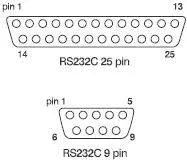
Figure 17.10 ‘D’ connectors for RS232C
Modems
A modem (MOdulator DEModulator) converts a digital signal into two audio tones so that the transmission can occur along a telephone line. Telephones are generally designed to accept frequencies between 300 Hz and 3.1 kHz. This relatively narrow bandwidth was chosen to allow speech to be transferred with undue loss of quality while allowing the largest number of calls to be passed along the same cable. Once the digital signals are on a telephone line then the range is unlimited.
A few metres
We can use the raw binary data transmitted over a simple cable (see Figure 17.11).
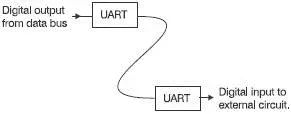
Figure 17.11 A very short range link up
Tens or hundreds of metres
We can convert the transmitted signal to RS232C or RS423A as necessary (see Figure 17.12).

Figure 17.12 Around the building
Unlimited range
Add a modem and link by telephone or optic fibre (see Figure 17.13).
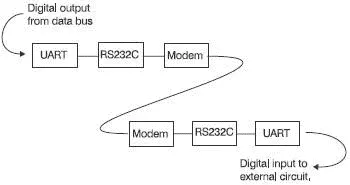
Figure 17.13 Around the world
A piece of optic fibre is a solid piece of glass or plastic. The plastic fibre is about 1 mm in diameter and is suitable only for short ranges of a few tens of metres but it has the advantage of being cheap and easy to use. Its useful range is limited by the clarity of current plastics. The special silica glass is incredibly clear and hence has much lower losses and able to be used over any distance, with suitable repeaters. It also has a much smaller diameter – only about 125 μm before the external protective layers are added.
If a light is shone into the end of an optic fibre, it will reflect off the inner surfaces along the cable. The light source used is a laser operating in the infrared region of the spectrum. To use it as a means of sending a digital signal we need to switch the light source on and off and then detect the flashes of light at the far end of the cable by a photoelectric cell. The losses can be made up by repeaters just as we do on copper-based systems, so range of operation is no problem. The optic fibre does not suffer from any electric noise pickup along the route and has an enormous bandwidth. In one sense, it is not really optional because nearly all long distance telephone cables are now optic fibres. (See Further reading for our companion volume An Introduction to Fiber Optics .)
If we are constructing our own fibre optic link, all we need to do is to buy the laser (or light emitting diodes (LEDs)) and the photocells and some plugs and sockets to connect it all up. It can be used to replace the copper cable in any of the systems described (see Figure 17.14). Careful! The infrared light from the lasers can cause immediate and irreversible eye damage. We must always remember that we are down to our last pair of eyes.
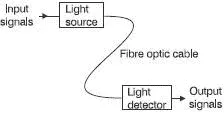
Figure 17.14 A fibre optic link – any distance
Data transfer rates
Using a single optic fibre for serial transmission, typical data transfer rates of 100 Mbytes/s are available up to 10 km. Very high speed data transfer of 1 Gbyte/s can be achieved up to 100 m using parallel transmission along a bunch of fibre optic cables.
In each case, choose the best option.
1 The fastest design of analogue to digital conversion is a:
(a) ramp converter.
(b) flash converter.
(c) comparator.
(d) successive approximation converter.
2 Quantization error can be reduced by:
(a) increasing the number of levels in the ADC.
(b) increasing the speed of the conversion.
(c) using vectored interrupts rather than polling.
(d) using a flash converter.
3 Using the RS232C standard, a binary 0 is most likely to be transmitted as:
(a) –4 V.
(b) +2 V.
(c) –5 V.
(d) +10 V.
4 A modem is:
(a) a type of USART.
(b) normally connected between the UART and the RS232C converter.
(c) only used in fibre optic systems.
(d) used to convert digital signals into audio tones for transmission over telephone cables.
5 This received transmission has sixteen bits of data and includes an error. It is using odd parity on the ones in a block of 25 bits:
0000111010111000100110011.
The corrected data is:
(a) 1000111010111000101110011.
(b) 0000111010111000101110010.
(c) 0000111010111000101110011.
(d) 0000111010111000100110011.
18. Test equipment and fault-finding
This chapter is intended to give some pointers towards finding faults in a microprocessor-based system. This chapter is firmly based on experience and could equally well have been entitled, ‘Mistakes I have made’.
The whole process of fault-finding should be undertaken slowly and carefully. There is a popular misconception that you have to keep busy, taking measurements, making adjustments and changing components. But, in fact, most of the time is spent just sitting and thinking (don’t forget the last two words!).
Collect the symptoms and write them down. Be wary of other people’s idea of the symptoms. If they have misunderstood what is happening you could waste hours or days going off at a tangent. If you forget to write them down, then sooner or later you will be back repeating the same checks.
In most cases, a piece of equipment or a circuit fails due to a single fault. Two simultaneous but unconnected faults are very rare. There are two popular ways of converting a small problem into a large one. These are static electricity and plugs etc.
Static electricity
When two different materials rub against each other, some negative electrons tend to migrate from one material to the other. This results in a voltage difference between the two materials. The amount of voltages can be very high – several thousand volts. If we walk across a carpet or sit on a plastic covered chair, we can become lethal to an integrated circuit designed for 5 V. Many integrated circuits have antistatic precautions built in but they have limited success. There is a trade-off here in that the better we make the antistatic precautions, the slower the integrated circuit can switch.
We can overcome the problem by reducing the build up of static by allowing it to leak away. In carpets, clothes and furniture we can do this by adding a wax or polish that absorbs and holds a small quantity of moisture. A slight dampness is a very effective way of preventing static problems. For this reason, the weather and air humidity is important. The death rate of integrated circuits tends to vary seasonally! It is not helped by air-conditioned plant where the humidity is low. The effect of static electricity on integrated circuits is difficult to predict. It generally causes small localized failures which can have very peculiar effects.
Читать дальшеИнтервал:
Закладка:
Похожие книги на «Introduction to Microprocessors and Microcontrollers»
Представляем Вашему вниманию похожие книги на «Introduction to Microprocessors and Microcontrollers» списком для выбора. Мы отобрали схожую по названию и смыслу литературу в надежде предоставить читателям больше вариантов отыскать новые, интересные, ещё непрочитанные произведения.
Обсуждение, отзывы о книге «Introduction to Microprocessors and Microcontrollers» и просто собственные мнения читателей. Оставьте ваши комментарии, напишите, что Вы думаете о произведении, его смысле или главных героях. Укажите что конкретно понравилось, а что нет, и почему Вы так считаете.
